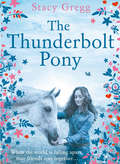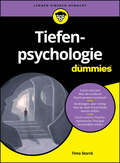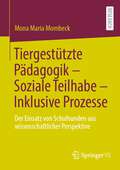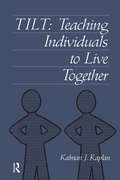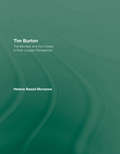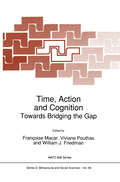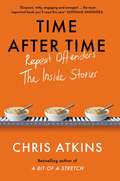- Table View
- List View
The Thunderbolt Pony
by Stacy GreggA dramatic and emotional story about one girl’s determination to stand by her beloved animals – and her refusal to give up, even in the face of impossible odds.
Thursday Nights at the Bluebell Inn: Six ordinary women tell their hidden stories of love and loss
by Kit FieldingSix women, one aim and the stories they never told.Each week, six women of different ages and from varying backgrounds come together at The Bluebell Inn. They form an unlikely and occasionally triumphant, ladies darts team, but it is there hidden stories of love and loss that in the end binds them. There is the Irish widow with a heartbreaking secret; the young daughter of a gypsy family experiencing love for the first time; a cat woman alone with her memories who must return to the place of her birth before it's all too late. Their unspoken stories are ones of heartache, dull marriages, abusive relationships, lost loves and secret hopes. These displaced women know little of each other's lives, but their weekly meetings at their local pub weave a delicate and sustaining connection between them all, a constant that maybe they can rely on as the crossroads in their individual lives threaten to overwhelm.Raw, funny and devastating, all of life can be found at the Bluebell.
Tibetische Medizin für den Westen: Das Archetypen-Meridian-System in der Praxis
by Sathya Allesandra Bernhard bin Saif Wolfgang Christian Bernhard ben Saif Sabine KnollErstmals treffen sich die fernöstlichen zwölf Hauptmeridiane und das westliche Wissen rund um die zwölf inneren Archetypen in einem sogenannten Archetypen-Meridian-System. Die Ärztin der Tibetischen Medizin, Psychologin und Philosophin und der langjährige Trainer aus dem Seminar- und Wirtschaftsbereich haben ihr Wissen aus Ost und West verbunden und dabei verblüffende Übereinstimmungen entdeckt. Ihr Buch liefert eine praktikable Anleitung für alle, die einen leicht verständlichen Zugang zur Tibetischen Medizin mit Verbindung zum Westen suchen.
Tic Disorders, Trichotillomania, and Other Repetitive Behavior Disorders: Behavioral Approaches to Analysis and Treatment
by Douglas Woods Raymond MiltenbergerTics, trichotillomania, and habits such as thumb-sucking and nail-biting tend to resist traditional forms of therapy. Their repetitiveness, however, makes these dissimilar disorders particularly receptive to behavioral treatment. Now in soft cover for the first time, this is the most comprehensive guide to behavioral treatment for these common yet understudied disorders. Tic Disorders is geared to researchers but accessible to to patients and their families as well.
Tics and Tourette Syndrome: A Handbook for Parents and Professionals
by Uttom ChowdhuryThis essential guide to tic disorders and Tourette Syndrome tackles problems faced both at home and at school, such as adjusting to the diagnosis, the effect on siblings and classroom difficulties. Dr Chowdhury offers advice on how to manage symptoms, describing practical techniques such as habit reversal and massed practice and reviewing available medical treatments. In clear, accessible language, this book explains the clinical signs and symptoms of Tourette and related conditions, and their possible causes. Presenting strategies for dealing with associated difficulties, including low self-esteem, anger-management and bullying, this book will be invaluable to parents, teachers, social workers and other professionals.
Tics and Tourette Syndrome: A Handbook for Parents and Professionals (PDF)
by Uttom ChowdhuryThis essential guide to tic disorders and Tourette Syndrome tackles problems faced both at home and at school, such as adjusting to the diagnosis, the effect on siblings and classroom difficulties. Dr Chowdhury offers advice on how to manage symptoms, describing practical techniques such as habit reversal and massed practice and reviewing available medical treatments. In clear, accessible language, this book explains the clinical signs and symptoms of Tourette and related conditions, and their possible causes. Presenting strategies for dealing with associated difficulties, including low self-esteem, anger-management and bullying, this book will be invaluable to parents, teachers, social workers and other professionals.
The Tidal Model: A Guide for Mental Health Professionals
by Prof Philip Barker Poppy Buchanan-BarkerThe Tidal Model represents a significant alternative to mainstream mental health theories, emphasising how those suffering from mental health problems can benefit from taking a more active role in their own treatment. Based on extensive research, The Tidal Model charts the development of this approach, outlining the theoretical basis of the model to illustrate the benefits of a holistic model of care which promotes self-management and recovery. Clinical examples are also employed to show how, by exploring rather than ignoring a client's narrative, practitioners can encourage the individual's greater involvement in the decisions affecting their assessment and treatment. The appendices guide the reader in developing their own assessment and care plans. The Tidal Model's comprehensive coverage of the theory and practice of this model will be of great use to a range of mental health professionals and those in training in the fields of mental health nursing, social work, psychotherapy, clinical psychology and occupational therapy.
The Tidal Model: A Guide for Mental Health Professionals
by Prof Philip Barker Poppy Buchanan-BarkerThe Tidal Model represents a significant alternative to mainstream mental health theories, emphasising how those suffering from mental health problems can benefit from taking a more active role in their own treatment. Based on extensive research, The Tidal Model charts the development of this approach, outlining the theoretical basis of the model to illustrate the benefits of a holistic model of care which promotes self-management and recovery. Clinical examples are also employed to show how, by exploring rather than ignoring a client's narrative, practitioners can encourage the individual's greater involvement in the decisions affecting their assessment and treatment. The appendices guide the reader in developing their own assessment and care plans. The Tidal Model's comprehensive coverage of the theory and practice of this model will be of great use to a range of mental health professionals and those in training in the fields of mental health nursing, social work, psychotherapy, clinical psychology and occupational therapy.
Tie a Knot and Hang on: Providing Mental Health Care in a Turbulent Environment
by Teresa ScheidTie a Knot and Hang On is an analysis of mental health care work that crosses the borders of diverse sociological traditions. The work seeks to understand the theoretical and empirical linkages between environmental pressures and activities and how these intersect with organizations and individuals. The work draws upon a research tradition that sees the issue of mental health care in terms of institutional pressures and normative values. The author provides a description and a sociological analysis of mental health care work, emphasizing the interaction of professionally generated norms that guide the "emotional labor" of mental health care workers, and the organizational contexts within which mental health care is provided. She concludes with a discussion of emerging institutional forces that will shape the mental health care system in the future. These forces are having greater impact than ever before as managed care comes to have a huge fiscal as well as institutional impact on the work of mental health professionals. Scheid's book is a brilliant, nuanced effort to explain the institutional demands for efficiency and cost containment with the professional ethics that emphasize quality care for the individual. The book is essential reading for those interested in mental health care organizations and the providers responding to these seemingly larger, abstract demands. The work offers a rich mixture not just of the problems faced by mental health care personnel, but the equilibrium currently in place u an equilibrium that shapes the theory of the field, no less than the activities of its practitioners. Teresa L. Scheid is associate professor of sociology, at the University of North Carolina at Charlotte. She has published widely in the area, including major essays in Sociology of Health and Illness, Sociological Quarterly, Perspectives on Social Problems, and The Journal of Applied Behavioral Science.
Tie a Knot and Hang on: Providing Mental Health Care in a Turbulent Environment
by Teresa ScheidTie a Knot and Hang On is an analysis of mental health care work that crosses the borders of diverse sociological traditions. The work seeks to understand the theoretical and empirical linkages between environmental pressures and activities and how these intersect with organizations and individuals. The work draws upon a research tradition that sees the issue of mental health care in terms of institutional pressures and normative values. The author provides a description and a sociological analysis of mental health care work, emphasizing the interaction of professionally generated norms that guide the "emotional labor" of mental health care workers, and the organizational contexts within which mental health care is provided. She concludes with a discussion of emerging institutional forces that will shape the mental health care system in the future. These forces are having greater impact than ever before as managed care comes to have a huge fiscal as well as institutional impact on the work of mental health professionals. Scheid's book is a brilliant, nuanced effort to explain the institutional demands for efficiency and cost containment with the professional ethics that emphasize quality care for the individual. The book is essential reading for those interested in mental health care organizations and the providers responding to these seemingly larger, abstract demands. The work offers a rich mixture not just of the problems faced by mental health care personnel, but the equilibrium currently in place u an equilibrium that shapes the theory of the field, no less than the activities of its practitioners. Teresa L. Scheid is associate professor of sociology, at the University of North Carolina at Charlotte. She has published widely in the area, including major essays in Sociology of Health and Illness, Sociological Quarterly, Perspectives on Social Problems, and The Journal of Applied Behavioral Science.
Tiefe Hirnstimulation
by J. K. Krauss F. Mundinger J. Volkmann A. StrupplerDie tiefe Hirnstimulation hat sich rasch etabliert bei der Behandlung von sonst therapierefraktären Bewegungsstörungen. Sie ist eine wichtige Schnittstelle zwischen den Disziplinen der klinischen Neurologie und der funktionellen Neurochirurgie. Dieses Buch bietet erstmalig einen umfassenden Überblick über die tiefe Hirnstimulation bei Bewegungsstörungen wie bei Parkinsonkrankheit, verschiedenen Tremorformen und Dystonie. Darüber hinaus werden auch Möglichkeiten der tiefen Hirnstimulation bei therapierefraktären Schmerzen, bei Epilepsie und bei psychiatrischen Erkrankungen dargestellt, die das etablierte Indikationsspektrum erweitern könnten. Die von national und international anerkannten Experten verfassten Kapitel decken alle relevanten Aspekte ab: historische Entwicklung, anatomische und physiologische Grundlagen, technische Grundlagen, operatives Vorgehen, klinische Ergebnisse, Patientenselektion und postoperative neurologische Betreuung von Patienten mit implantierten Hirnstimulationssystemen.
Tiefenpsychologie für Dummies (Für Dummies)
by Timo StorckDieses Buch erklärt wie die Tiefenpsychologie aus der Psychoanalyse entstanden ist und warum sie sich zur am zweithäufigsten angewendeten Therapiemethode gemausert hat. Sie erfahren was es mit Schlagworten wie Verdrängung, Sexualität und Fehlleistung auf sich hat, wie eine tiefenpsychologische Therapie abläuft, wie sie wirkt und für wen sie überhaupt in Frage kommt. Auch ein Blick in den Alltag kommt nicht zu kurz. Sie werden erstaunt sein, welche Bedeutung die Psychoanalyse in Kultur und Politik spielt.
Tiefenpsychologische Bindungsanalyse: Modell und Methode – für ärztliche und psychologische Psychotherapeuten (Psychotherapie: Praxis)
by Bernd NockemannDiese Monografie wagt den Versuch, die Durcharbeitung der frühen, prägenden Bindungserfahrungen für das Setting der tiefenpsychologisch fundierten Psychotherapie zu erschließen. Der Autor lässt uns teilhaben an seinen Überlegungen zu einem streng naturwissenschaftlich gedachten Aufbau unserer aller Entwicklungs- und Veränderungsbedingungen, vom einfachen Reflex bis zur komplexen Bindungsbeziehung. Aus dem Inhalt: Die auffälligen Überschneidungen der Bindungstheorie und der Selbstpsychologie bilden den Kern der grundlegenden theoretischen Weiterentwicklung des psychodynamischen Modells. Mit den Begrifflichkeiten der Bindungstheorie gelingt es dem Autor, die Modellvorstellungen der Selbstpsychologie um entscheidende Elemente zu ergänzen. Psychodynamische Therapien werden mit der TBA überschaubarer, leichter zu handhaben (mit konkreten Fragen zur Bindungsgeschichte) und wirkungsvoller. Mit einem Geleitwort von Klaus E. Grossmann. Über den Autor: Bernd Nockemann ist niedergelassener Arzt für Psychosomatische Medizin und Psychotherapie in Radevormwald. Sein Anliegen ist, die Methode der Tiefenpsychologischen Bindungsanalyse den psychodynamisch orientierten Kolleginnen und Kollegen auf einer theoretisch gut fundierten und verständlichen Basis nutzbar zu machen. In seiner Freizeit liebt Bernd Nockemann Sport und das Zusammensein mit seiner Familie und Freunden am selbstgebauten Pizzaofen sowie die Interpretation gepflegter Polyphonie, von klassischen Oratorien bis Comedian Harmonists.
Tiergestützte Pädagogik – Soziale Teilhabe – Inklusive Prozesse: Der Einsatz von Schulhunden aus wissenschaftlicher Perspektive
by Mona Maria MombeckLehrkräfte setzen Hunde im Unterricht ein, um die soziale Inklusion zu fördern. Doch welchen Einfluss hat tiergestützte Pädagogik auf die sozialen Strukturen in Schulklassen? Wie lassen sich diese Einflüsse erklären und welche Schlussfolgerungen können für die Förderung von sozialer Inklusion abgeleitet werden? Diese Fragen werden mit einer der ersten empirischen Erhebungen zu Auswirkungen tiergestützter Pädagogik auf die soziale Partizipation von Schüler*innen beantwortet. Der Einfluss von Schulhunden wird gezielt hinsichtlich des Wohlbefindens, der Arbeitsatmosphäre und sozialer Beziehungen zwischen den Lernenden, aber auch zwischen Klasse und Lehrkraft erhoben. Die Analyse der Ergebnisse zeigt: Mithilfe von tiergestützter Pädagogik werden soziale Strukturen positiv beeinflusst und Teilhabemöglichkeiten geschaffen. Vor dem Hintergrund pädagogischer und soziologischer Theorien werden die Ergebnisse interpretiert und erklärt. Leser*innen erhalten praktische Hinweise für die Förderung sozialer und emotionaler Entwicklung von Kindern und Jugendlichen sowie für die Vermittlung inklusiver Werte und die Beziehungsgestaltung.
Tiergestützte Therapie mit Hunden: Grundlagen, Tierethik und Praxis der therapeutischen Arbeit
by Katharina BleschDie tiergestützte Therapie ist seit einigen Jahren in aller Munde und wird immer häufiger auch in die psychotherapeutische Behandlung von Menschen integriert. Doch wie genau können Therapiebegleithunde die psychotherapeutische Arbeit erweitern und unterstützen? Wie lassen sich dabei Tierschutz und Menschenwohl vereinen? Welche Hunde eignen sich für den Einsatz als Therapiebegleithund und wie werden sie auf ihren Einsatz vorbereitet?Mit diesem Fachbuch erhalten Sie einen praxisnahen und lebendigen Einblick in die therapeutische Arbeit mit Hunden. Neben einem Überblick über die Grundlagen sowie tierschutzrechtliche und ethische Aspekte der hundegestützten Therapie von Menschen werden konkrete Übungen im Rahmen eines hundegestützten Selbstsicherheitstrainings bildhaft und per Video beschrieben und geben so Inspiration für die therapeutische Arbeit mit Mensch und Tier in verschiedenen Institutionen und Situationen.
Tierisch kultiviert - Menschliches Verhalten zwischen Kultur und Evolution
by Ulrich KühnenDie Weisheit im Kopf, den Affen im Rucksack Fremde Länder, fremde Sitten, sagt bereits der Volksmund: Unsere Kultur prägt, wie wir denken, fühlen und handeln. Zugleich jedoch sind wir Teil der Tierwelt, und auch „der Affe in uns“ wird immer wieder sichtbar. Wir sind zugleich kulturbegabt und doch nur höher entwickelte Primaten. Aber welche Anteile unseres Verhaltens sind kulturell geformt, welche evolutionär? Wie tiefgreifend bestimmt die Kultur unser Denken und wann schlägt doch unser äffisches Erbe durch? Wie wurden wir überhaupt zu Kulturwesen und wieso entwickelten sich die Kulturen so unterschiedlich? Formt unsere Kultur auch, was wir sehen und wahrnehmen? Wollen Männer wirklich immer nur das eine? Wie entwickeln wir moralische Vorstellungen? Hat das Gute eine Chance in einer feindlichen Umwelt? Wo kommt das Mitgefühl her? Wieso glauben wir an Gott? Dieses Buch nimmt den Leser mit auf eine spannende Reise in die Tiefen des Bewusstseins und vermittelt verblüffende Einsichten in die Grundlagen unseres Erlebens und Verhaltens. Die großen Fragen des Lebens werden auf erfrischend neue Weise betrachtet, indem jüngste Erkenntnisse der kulturvergleichenden Forschung und der Evolutionspsychologie im Zusammenhang betrachtet werden. Auf anschauliche und teils überraschende Weise wird dem Leser vor Augen geführt, wie relativ doch die eigenen Sichtweisen oft sind. Ein Buch für alle Leser, die sich immer wieder neu die alte Frage stellen: Wer bin ich? _____ Der Mensch ist kulturbegabt und zugleich Teil der Tierwelt dieses Planeten. Er kann frei entscheiden, was er tun will, und hat enorme kulturelle Leistungen hervorgebracht; zugleich spiegeln seine Verhaltensweisen oftmals sehr alte evolutionäre Programme wider. Wo verlaufen die Grenzen, wo sind die Schnittstellen zwischen kulturell geformten und evolutionär geprägten Verhaltensanteilen? Lassen sie sich überhaupt voneinander trennen? Bestimmt die Kultur unser Denken und unsere Wahrnehmung - oder ist doch unser Primatenerbe maßgeblich? Wie entsteht unser inneres Bild von uns selbst und wie beeinflusst es, was wir tun? Warum können wir sowohl einfühlsam und sanftmütig als auch selbstsüchtig und gewalttätig agieren? Was ist die Natur des Menschen? Dies sind nur einige der vielen spannenden Fragen, denen dieses leicht verständlich und mit Humor geschriebene Buch nachgeht. Es zeigt, warum wir Menschen zwar oftmals die Weisheit im Kopf haben, aber dann doch von dem Affen in unserem Rucksack die Richtung gewiesen bekommen.
The Ties of Later Life (Perspectives On Aging And Human Development Ser.)
by Jon HendricksHelps you recognise the continuity that runs across the generations from grandparents to grandchildren. This work provides a clear perspective on the actual experiences of the lives of our family and friends.
The Ties of Later Life (Perspectives On Aging And Human Development Ser.)
by Jon HendricksHelps you recognise the continuity that runs across the generations from grandparents to grandchildren. This work provides a clear perspective on the actual experiences of the lives of our family and friends.
Tilt: Teaching Individuals To Live Together
by Kalman J. KaplanAn alternative to existing bipolar choices, this book looks at individuals and their distances from the self (individuation-deindividuation) and from others (attachment-detachment). Simultaneously theoretical, empirical, and applied, this book can be reasonably applied to all types of individuals involved in interpersonal situations regardless of culture, age, gender, or sexual orientations. Broken into four parts, In the first part, Definitions and Measurements, the author includes an introduction to the Individuation-Attachment Questionnaire.Implications of TILT for Individuals is the basis for part two and includes a view of TILT across the life span. The next section extends the analysis to TILT for Couples and Families. The clinician, counselors, and individuals attempting to help himself/herself are addressed in the final part: TILT for the Clinician and includes application of TILT to everyday life.The text brings to life, through extensive description, the questions and situations consistently raised in couples therapy: space-too much or not enough. TILT: Teaching Individuals To Live Together presents a unique model of individuation and attachment and was developed to facilitate the understanding of the complex relationship between these two developmental processes across the life span. The model shows how we gradually develop our boundaries and hence reduce the need for defensive interpersonal walls. The TILT Model has applications in the fields of therapy, education, and organizational development. Thus, it will be of interest to mental health professionals including psychotherapists, psychologists, counselors, social workers, and marriage and family therapists. Practitioners of transactional analysis will find this book of supreme interest and usefulness.
Tilt: Teaching Individuals To Live Together
by Kalman J. KaplanAn alternative to existing bipolar choices, this book looks at individuals and their distances from the self (individuation-deindividuation) and from others (attachment-detachment). Simultaneously theoretical, empirical, and applied, this book can be reasonably applied to all types of individuals involved in interpersonal situations regardless of culture, age, gender, or sexual orientations. Broken into four parts, In the first part, Definitions and Measurements, the author includes an introduction to the Individuation-Attachment Questionnaire.Implications of TILT for Individuals is the basis for part two and includes a view of TILT across the life span. The next section extends the analysis to TILT for Couples and Families. The clinician, counselors, and individuals attempting to help himself/herself are addressed in the final part: TILT for the Clinician and includes application of TILT to everyday life.The text brings to life, through extensive description, the questions and situations consistently raised in couples therapy: space-too much or not enough. TILT: Teaching Individuals To Live Together presents a unique model of individuation and attachment and was developed to facilitate the understanding of the complex relationship between these two developmental processes across the life span. The model shows how we gradually develop our boundaries and hence reduce the need for defensive interpersonal walls. The TILT Model has applications in the fields of therapy, education, and organizational development. Thus, it will be of interest to mental health professionals including psychotherapists, psychologists, counselors, social workers, and marriage and family therapists. Practitioners of transactional analysis will find this book of supreme interest and usefulness.
Tim Burton: A Post-Jungian Perspective
by Helena Bassil-MorozowTim Burton’s films are well known for being complex and emotionally powerful. In this book, Helena Bassil-Morozow employs Jungian and post-Jungian concepts of unconscious mental processes along with film semiotics, analysis of narrative devices and cinematic history, to explore the reworking of myth and fairytale in Burton’s gothic fantasy world. The book explores the idea that Burton’s lonely, rebellious ‘monstrous’ protagonists roam the earth because they are unable to fit into the normalising tendencies of society and become part of ‘the crowd’. Divided into six chapters the book considers the concept of the archetype in various settings focusing on: the child the monster the superhero the genius the maniac the monstrous society. Tim Burton: The Monster and the Crowd offers an entirely fresh perspective on Tim Burton’s works. The book is essential reading for students and scholars of film or Jungian psychology, as well as anyone interested in critical issues in contemporary culture. It will also be of great help to those fans of Tim Burton who have been searching for a profound academic analysis of his works.
Tim Burton: A Post-Jungian Perspective
by Helena Bassil-MorozowTim Burton’s films are well known for being complex and emotionally powerful. In this book, Helena Bassil-Morozow employs Jungian and post-Jungian concepts of unconscious mental processes along with film semiotics, analysis of narrative devices and cinematic history, to explore the reworking of myth and fairytale in Burton’s gothic fantasy world. The book explores the idea that Burton’s lonely, rebellious ‘monstrous’ protagonists roam the earth because they are unable to fit into the normalising tendencies of society and become part of ‘the crowd’. Divided into six chapters the book considers the concept of the archetype in various settings focusing on: the child the monster the superhero the genius the maniac the monstrous society. Tim Burton: The Monster and the Crowd offers an entirely fresh perspective on Tim Burton’s works. The book is essential reading for students and scholars of film or Jungian psychology, as well as anyone interested in critical issues in contemporary culture. It will also be of great help to those fans of Tim Burton who have been searching for a profound academic analysis of his works.
TIMBER Psychotherapy: For PTSD, Depression and Traumatic Psychosis
by Basant Pradhan Narsimha R. Pinninti Shanaya RathodTIMBER psychotherapy is a novel, translational and biomarker informed, mindfulness-based cognitive behavioral therapy approach that addresses some of the current treatment gaps for PTSD, depression and traumatic psychosis. This treatment manual offers practitioners and patients alike a step-by-step guide to TIMBER (acronym for Trauma Interventions using Mindfulness Based Extinction and Reconsolidation of memories) psychotherapy, and has been divided into four parts: Understanding Complex Trauma and Traumatic Psychosis; Methodology and Application; Training Professionals; and Policy Implications & Future Research Directions. In addition to a strong rationale and evidence base for the TIMBER approach, the book also provides case examples accompanied by videos (available separately). Its special features include reproducible client handouts, assessment tools, and a list of resources for training to use TIMBER.
Time, Action and Cognition: Towards Bridging the Gap (NATO Science Series D: #66)
by William J. Friedman VivianePouthas FrançoiseMacarThis volume is the outcome of the NATO Advanced Research Workshop on Time, Action and Cognition. which was held in Saint-Malo, France, in October 1991. The theme - time in action and cognition of time - was sparked by growing awareness in informal meetings between mostly French-speaking time psychologists of the need to bring together time specialists in the areas of development, motor behavior, attention, memory and representations. The workshop was designed to be a forum where different theoretical points of view and a variety of empirical approaches could be presented and discussed. Time psychologists tended to draw conclusions restricted to their specific fields of interest. From our own experience, we felt that addressing a common issue - possible relationships between time in action and representations of time - could lead to a more comprehensive approach. We are endebted to NATO for allowing us to bring this idea to fruition. We take this opportunity as well to express our thanks to Cognisciences ( Cognisud section) -- an active interdisciplinary research organization - for its financial backing and the CNRS for its scientific support.
Time After Time: The Inside Story of Why Prisoners Reoffend
by Chris AtkinsBritish prisoners have to endure the most inhumane and barbaric conditions imaginable, so why do so many of them keep going back? Former inmate and documentary maker Chris Atkins has spent the last six years tracking the fortunes of a dozen repeat offenders to understand why the state fails to keep them out of trouble. Featuring funny, wild, and funny stories, Time After Time exploits Chris's unprecedented access to the criminal underworld to understand why the system actually makes reoffending all but inevitable for ex prisoners.
